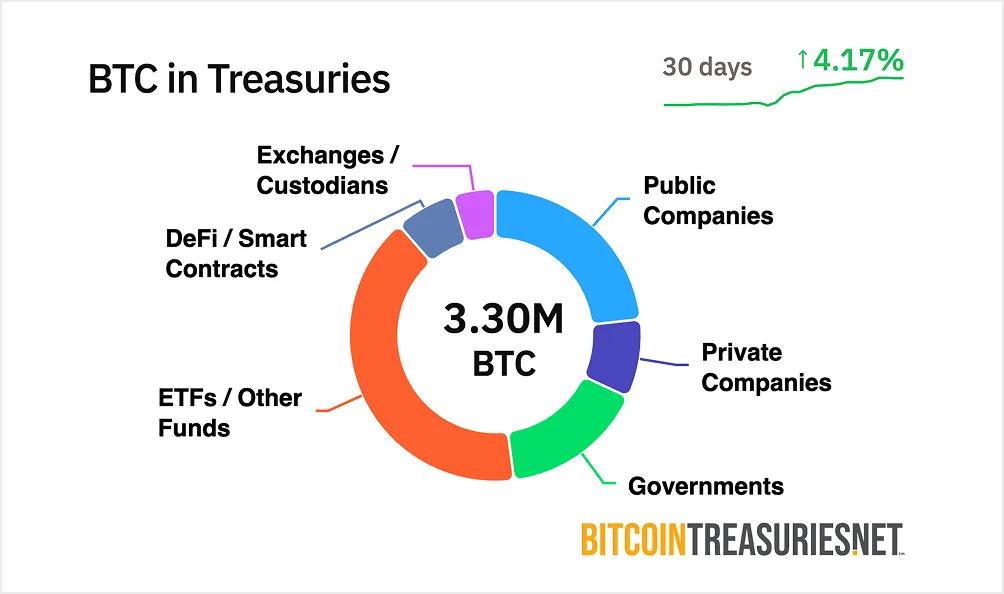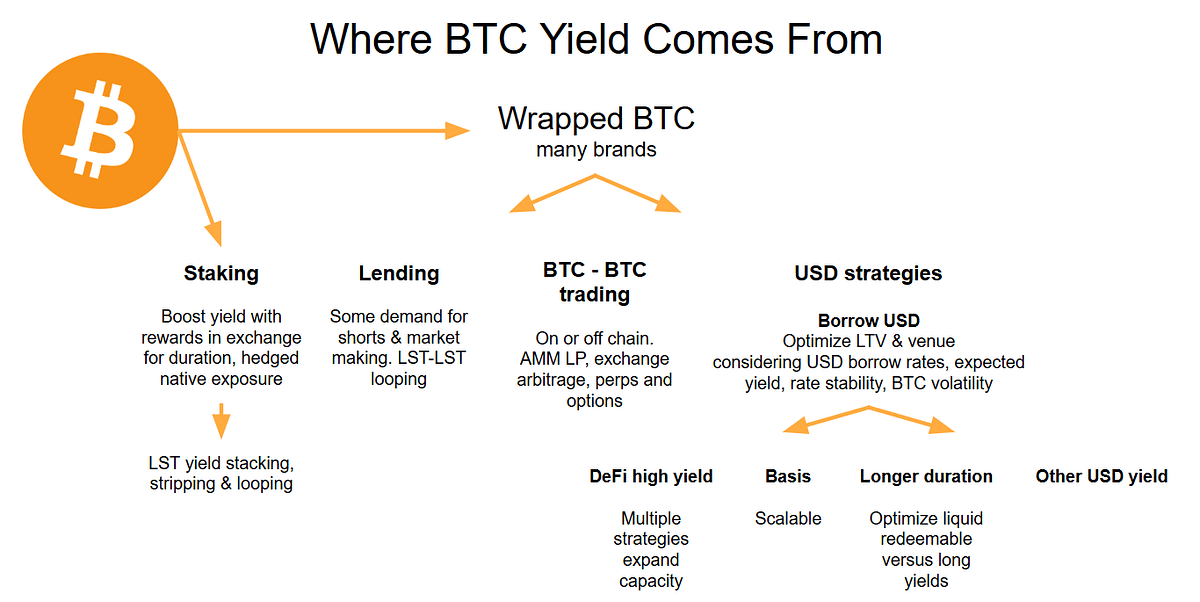ビットコインのアイデンティティ危機は終わりました。 何年もの間、機関投資家はBTCをデジタルゴールドと見なして扱いました - 冷蔵庫に放置され、ゆっくりと価値を高め、全く収益を生まない資産でした。
しかし、2025年にはその物語は根本的に変わりました。ビットコインはもはや非活動的な資本ではなく、オンチェーンの展開戦略、構造化レンディングフレームワーク、機関投資家向けのトレジャリーマネージメントを通じて意味のある利回りを生成することが可能な生産的なインフラとして捉えられるようになりました。
この変革の触媒は投機的な熱狂ではありません。インフラの成熟です。規制の明確化、機関向けカストディソリューション、コンプライアンスに準拠した利回りプロトコルが合流し、企業トレジャリー、資産マネージャー、ソブリンファンドが保有するビットコインを収益を生む戦略に展開できるようになったメカニズムを解放しましたが、安全性やコンプライアンスを犠牲にすることなくです。この変化はビットコインの第二幕を象徴します - アクセスと蓄積を超えて、積極的な資本展開へのシフトです。
なぜ今これが重要なのでしょうか?ビットコインETFがアクセスの問題を解決しました。2025年第3四半期までに、スポットビットコインETFは300億ドル以上のネットインフローを引き付け、ビットコインを伝統的なポートフォリオのための正常化された資産クラスに変えました。しかし、受動的な露出だけでは機会費用の問題に対処することはできません。数億ドルをビットコインに保有する機関 - 現在、ビットコインの間で機関保有は2000億ドルを超えています - は、他のトレジャリー資産に匹敵する収益を上げるよう、強いプレッシャーに直面しています。利回り展開が次のフロンティアであり、それをサポートするインフラはついに運用されています。
なぜ機関投資家はビットコインの利回りを望むのか

企業財務は単純な原則に基づいて運営されています: 資本は働かなければならない。ポートフォリオマネージャーは資産を回転させ、ポジションをヘッジし、期間を最適化し、可能な限り利回りを引き出します。しかし、ほとんどの機関ビットコイン保有は完全に未稼働であり、年間で10から50ベーシスポイントのカストディコストを負わせる一方で、全く収益を生み出していません。 固定および変動利回りモデルの区別は、リスク管理において重要です。変動利回り戦略は市場の状況に結びついており、貸付金利は需要が高い時に上昇し、静かな時期には低下します。対照的に固定利回り商品は、利用率に依存しない構造化ノートやデリバティブ戦略を通じて事前に決められたリターンを提供します。固定構造はしばしばカバードコールライティングやベーシストレーディング を使用して予測可能な収入ストリームを生成しますが、ビットコインが大幅に値上がりすると通常は上昇が制限されます。
これらの戦略を支えるインフラは、ますます洗練されてきています。BitGo、Anchorage Digital、BNY Mellon などのカストディアンは マルチパーティ計算セキュリティ、規制の準拠、および保険カバレッジを備えた機関向けソリューションを提供しています。これらのカストディアンは、2022年以降、ハードウェアセキュリティモジュールや分散キー管理のような革新を通じて成功した侵入を80%削減しました。
コンプライアンスと監査要件はもはや後回しにされません。主要なプロトコルは、MiCAのような国際報告基準と統合し、金融機関が進化する規制要件を満たすことを確保します。四半期ごとに公開される監査は準備金の証明を発行し、ガバナンスフレームワークはプロトコルのパラメーターを管理するためにマルチシグDAOを採用、取引の透明性が担保の健全性をリアルタイムで監視可能にします。
実世界での導入は急速に拡大しています。MicroStrategy (現在のStrategy)はビットコイントレジャリーの蓄積を先駆けたが、他の企業も積極的な導入に向かって動いています。Jiuzi Holdings は、1億ドルのビットコイントレジャリー計画を発表し、それを財務管理フレームワークの一部として利回り戦略を明確に検討しています。GameStopは2025年3月に発表し、転換社債発行を通じてビットコインをトレジャリー準備に組み入れると発表し、小売業者さえも構造化されたビットコインエクスポージャーを模索していることを示しています。
蓄積から導入へのシフトは、おそらくStrategyの進化において最も顕著です。2025年7月時点で、同社は62万8000 BTCを保有しており、世界最大の企業ビットコインホルダーとなっています。Strategyのコアプレイブックは、資本調達による買収のままですが、収益メカニズムの探求を開始しています。2027年までに840億ドルの資本調達を目指した"$42/42"計画は、ますます保有する巨大なビットコインに対する収益を生む展開戦略を考慮している。
利回りメソッドと戦略タイプ

ビットコインの利回りを生成するメカニズムは、異なるリスクプロファイル、運用要件、およびリターン特性を持ついくつかの異なるカテゴリに分類されます。
市場中立戦略は、ビットコインの価格への方向性のないエクスポージャーなしで利回りを提供します。ベーシストレーディングは、スポットビットコインを購入し、同時に先物契約をショート、二つのポジション間の価格差を利用して利回りを得ることです。安定した市場条件では、このスプレッドは通常年率5-10%の利回りをもたらします。この戦略はデルタ中立型で、ビットコインが上昇しようが下降しようが、スポットと先物価格の収束から利益を得ます。
実行にはスポット市場と先物取引所の両方へのアクセスが必要です。機関は、カストディアンを通じてスポットビットコインの1000万ドルを購入し、次にCMEやBinanceのようなプラットフォームで等価の名目価値の先物をショートします。先物契約が満期に近づくにつれ、その価格はスポットに収束し、機関はベーシスを利益として獲得します。自動化されたボットがレートキャプチャを最適化し、ボラティリティのある期間中のスリッページを避けるためには実行速度が重要です。
資金調達率のアービトラージも同様に機能しますが、日付付き先物ではなく永久スワップを使用します。ブル市場では、永久スワップロングはショートに資金調達率を支払うことがあり、通常は年率2-5%です。機関はスポットビットコインをロングして永久契約をショートし、定期的な資金調達の支払いを収集します。この戦略は継続的な監視を要し、資金調達率が弱気時にネガティブに転じることで、利益を生む取引が損失を生むポジションになることがあります。
カバードコール戦略は、機関がビットコインを保有し、これに対してコールオプションを売ることでプレミアム収入を得る](https://www.roundhillinvestments.com/etf/ybtc/) 最も広く採用された利回りメカニズムです。ビットコインの歴史的に高いインプライド・ボラティリティ (しばしば46%を超える) は、従来の資産に比べてより大きなオプションプレミアムに変換されます。
メカニズムは簡単です。トレジャリーが100 BTCを保有している場合、現在の価格から10%上の行使価格で30日後に満期のコールオプションを売ることができます。ビットコインが行使価格未満であれば、機関はプレミアムを保持します - 通常毎月ポジション価値の2-3%です。ビットコインが行使価格を超えて上昇した場合、ポジションは行使されますが、機関は行使価格と回収したプレミアムから利益を得ます。ブラックロックは2025年9月にiShares Bitcoin Premium ETFを申請し、ビットコイン利回り生成のためのカバードコール戦略へのメインストリームな機関関心を示唆しています。
欠点は機会コストです。強力なブル市場では、カバードコール戦略は従来の資産を下回ることが歴史的にあります、なぜなら上昇は行使価格で制限されるからです。2024年初めに10万ドルのストライクコールを売ったビットコイン保有者は、BTCがそのレベルを超えて急騰したときに重大な価値上昇を逃すことになるでしょう。保守的な実装では、現状価格より5-15%上の行使価格を設定することで、実質的なプレミアムを回収しつつある程度の上昇エクスポージャーを保存します。
いくつかのETFプロダクトは、現在カバードコール戦略を小売および機関アクセス用にパッケージ化しています。NEOS Bitcoin High Income ETFは2024年10月に発足し、レイヤーされたコールオプション売却を通じて22%の配当利回りを提供しています。 Roundhill Bitcoin Covered Call Strategy ETFは、合成ロングポジションに組み合わせた週足コールライティングを通じて4-8%のネットリターンを求めています。 これらのプロダクトは、洗練されたオプション戦略が機関展開用にスケールで運用可能であることを示しています。
構造化貸付およびボールト戦略は、より複雑な実装を示しています。Ribbon FinanceのようなDeFiオプションボールトは、ボラティリティに基づいた動的な行使価格の選定とアルゴリズム管理による利回りの最適化を自動で行います。利回りは年間5-10%で、プロトコルはすべての運用の複雑さを管理し、生産的な選定、ロール管理、プレミアム収集を行います。
プット売却ボールトは逆に作用します - 機関はビットコインに対するプットオプションを売り、プレミアムを回収する一方で、オプションが行使された場合により低い行使価格でBTCを買う義務を受け入れます。この戦略は4-8%の利回りを生成し、修正中に割引価格でビットコインを取得する可能性を持ちます。リスクは、機関がストライク価格に等しいステーブルコイン担保を維持する必要があり、他の場所で展開可能な資本を拘束することです。Content: remains foundational. Institutions cannot - and will not - deploy Bitcoin into protocols that require them to relinquish custody or expose private keys. Leading providers use multi-party computation (MPC) technology that distributes key fragments across multiple parties, ensuring no single entity can access funds unilaterally. MPC prevents insider theft even if one key fragment is compromised, since reconstructing a complete key requires multiple independent parties to coordinate.
Cold storage, multi-signature wallets, and hardware security modules form the backbone of institutional custody. Cold wallets keep private keys offline and air-gapped from internet connectivity, preventing remote attacks. Multi-signature approvals require multiple authorized parties to sign transactions, eliminating single points of failure. HSMs provide tamper-proof cryptographic protection, securing keys against physical theft or insider compromise.
Auditability and transparency are non-negotiable. Institutional investors require real-time visibility into collateral health, liquidation risks, and fund flows. Leading protocols publish quarterly proof-of-reserve audits verified by third parties, ensuring that reserves match outstanding obligations. All minting, burning, and transactional data should be publicly verifiable on-chain, allowing institutions to independently validate protocol solvency without relying solely on operator disclosures.
Governance controls prevent unauthorized transactions and manage protocol risk. Multi-signature DAOs collectively manage parameter changes, ensuring no single party can modify critical variables like collateralization ratios or liquidation thresholds. Institutions demand formal governance frameworks with time-locks on parameter changes, emergency pause mechanisms, and clear escalation procedures for addressing security incidents.
Regulatory compliance grows more complex as frameworks evolve. Markets in Crypto-Assets Regulation (MiCA) in the EU and Securities and Exchange Commission guidance in the U.S. establish custody standards, anti-money laundering requirements, and reporting obligations. The New York Department of Financial Services has laid out specific standards for crypto custody, requiring institutions to demonstrate compliance with regulatory frameworks before offering services to institutional clients.
The risks in Bitcoin yield deployment are meaningful and must be actively managed. Rehypothecation - lending out customer assets multiple times - remains a concern in centralized lending. Institutions must verify that custodians maintain 1:1 reserves and don't engage in undisclosed rehypothecation that could create systemic risk during stress periods.
Counterparty default represents the most obvious risk. If a lending platform becomes insolvent, depositors may lose some or all of their Bitcoin regardless of collateral arrangements. The 2024 surge in crypto hacking incidents, with approximately $2.2 billion stolen, demonstrates that even sophisticated platforms remain vulnerable. Institutions should diversify across multiple custodians and protocols, avoiding concentration risk that could result in catastrophic losses.
Liquidity mismatch between assets and liabilities can create stress during volatile periods. If an institution deposits Bitcoin into a lending protocol with instant redemption, but the protocol lends those assets for fixed terms, there's duration mismatch. During market dislocations, the protocol may not have sufficient liquidity to honor withdrawal requests, forcing redemption delays or suspensions. Institutions should clarify redemption terms upfront and maintain liquid reserves to handle operational needs.
The distinction between wrapped Bitcoin and native Bitcoin matters for risk assessment. Wrapped Bitcoin (wBTC) represents the vast majority of Bitcoin in DeFi, functioning as an ERC-20 token on Ethereum backed 1:1 by actual Bitcoin held by custodians like BitGo. Over $10 billion in wBTC circulates across Ethereum-based protocols, enabling BTC holders to access lending, trading, and yield farming on Ethereum.
The wBTC model relies on a federated custody structure where multiple institutions serve as merchants and custodians. While quarterly audits verify 1:1 backing, institutions must trust that custodians won't mismanage reserves or become insolvent. This centralization introduces risk that native Bitcoin on Layer 2 solutions like Rootstock or Lightning Network might avoid, though those ecosystems have far less mature yield infrastructure.
Smart contract risk applies to any DeFi deployment. Even well-audited protocols can contain vulnerabilities that malicious actors exploit. Institutions should prioritize protocols with multiple independent audits from firms like OpenZeppelin, Spearbit, and Cantina, active bug bounty programs offering six- or seven-figure rewards for vulnerability disclosure, and proven track records operating under stress conditions.
Compliance and audit frameworks must satisfy institutional risk committees. Realized yield versus implied yield must be transparent - some protocols advertise high APYs that include token rewards rather than actual cash yield. Slippage, trading costs, and gas fees can significantly erode returns in high-frequency strategies. Drawdown analysis showing maximum losses during adverse market conditions helps institutions understand worst-case scenarios.
The institutional crypto custody market is projected to grow at 22% CAGR to $6.03 billion by 2030, driven by demand for compliance-certified solutions. But growth depends on infrastructure providers solving these risk and compliance challenges at scale.
What This Means for Corporate Treasuries and Institutional Allocation
The shift from passive holding to active deployment fundamentally changes how corporate treasurers think about Bitcoin exposure. Rather than viewing BTC purely as an inflation hedge or speculative appreciation play, treasuries can now treat it as working capital that generates returns comparable to other liquid assets.
Consider a corporate treasurer managing $500 million in cash equivalents. Traditionally, that capital sits in money market funds yielding 4-5% or short-term commercial paper providing predictable returns. Now imagine 10% of that portfolio - $50 million - allocated to Bitcoin. At zero yield, that BTC generates no income while incurring custody costs. But deployed into a conservative yield strategy generating 4-6% annually, the position contributes meaningful treasury income while maintaining Bitcoin exposure.
The transformation of digital asset treasuries into working capital enables several strategic shifts. First, Bitcoin can function in vendor contracts and B2B settlements. Companies operating globally could denominate supplier agreements in BTC, using on-chain settlement rails that reduce forex conversion costs and settlement times. The yield generated on Bitcoin reserves offsets any volatility risk from holding a portion of working capital in digital assets.
Second, treasuries can use Bitcoin as collateral for liquidity management. Rather than selling BTC to raise cash - triggering taxable events and missing future appreciation - companies can post Bitcoin as collateral for stablecoin loans or credit facilities. Over-collateralized lending allows treasuries to access 50-75% of their Bitcoin's value in liquidity while maintaining long-term BTC exposure.
Third, yield deployment creates optionality for capital allocation. A treasury earning 5% annually on Bitcoin holdings can reinvest those returns into business operations, share buybacks, or additional Bitcoin accumulation. The compounding effect over multiple years significantly enhances total return compared to passive holding.
The psychological shift is equally important. CFOs and boards who viewed Bitcoin as speculative now see it as productive. Survey data showing 83% of institutional investors planning increased crypto allocations reflects growing confidence that Bitcoin can satisfy fiduciary obligations rather than serving as a moonshot bet. Yield deployment provides the bridge between crypto-native enthusiasm and institutional risk management requirements.
Portfolio behavior changes when Bitcoin generates income. Treasuries might allocate a larger percentage of reserves to BTC if they can earn yields comparable to bonds or treasuries. A conservative 2-3% allocation could expand to 5-10% if the risk-adjusted returns justify larger exposure. [Bernstein's
コンテンツ:残りの部分は、基盤となるものです。機関はビットコインをプロトコルに導入することはできませんし、しません。それには、彼らに保護者を手放させるか、秘密鍵をさらす必要があります。主要なプロバイダーは、マルチパーティ計算(MPC)技術を使用し、鍵フラグメントを複数のパーティに分散させることで、単一のエンティティが一方的に資金にアクセスできないようにしています。MPCは、鍵フラグメントの一部が侵害された場合でもインサイダーによる盗難を防ぎます。完全な鍵を再構築するには、複数の独立したパーティが連携する必要があります。
コールドストレージ、マルチシグネチャウォレット、ハードウェアセキュリティモジュールは、機関の保管の基盤を形成します。コールドウォレットは、秘密鍵をオフラインで保ち、インターネット接続からエアギャップすることで、リモート攻撃を防ぎます。マルチシグネチャの承認には、複数の認可されたパーティがトランザクションに署名する必要があり、単一障害点を排除します。HSMは改ざん防止の暗号化保護を提供し、物理的な盗難やインサイダーの妥協から鍵を保護します。
監査可能性と透明性は、妥協の余地がありません。機関投資家は、担保の健全性、清算リスク、資金の流れをリアルタイムで可視化できることを求めます。主要なプロトコルは四半期ごとに、第三者によって検証された準備金証明監査を公開しています。これにより、準備金が未払いの義務と一致することが保証されます。すべての鋳造、燃焼、トランザクションデータはオンチェーンで公に検証可能であるべきです。これにより、機関はオペレーターの開示に依存せずに、プロトコルの支払い能力を独自に検証することができます。
ガバナンス制御は、未承認のトランザクションを防ぎ、プロトコルのリスクを管理します。マルチシグネチャDAOは、パラメータの変更を集団で管理します。このため、担保化比率や清算閾値などの重要な変数を単一のパーティが変更することはできません。機関はパラメータの変更にタイムロックを設け、緊急停止メカニズム、セキュリティ事故へのエスカレーション手順の明確なフレームワークを要求します。
規制遵守は、フレームワークの進化に伴い複雑になります。EUのMarkets in Crypto-Assets Regulation (MiCA)および米国の証券取引委員会のガイダンスは、保管基準、資金洗浄防止要件、および報告義務を確立します。ニューヨーク州金融サービス局は、機関のクライアントにサービスを提供する前に規制フレームワークに準拠していることを証明する必要があります。
ビットコインの利回りの導入におけるリスクは重要であり、積極的に管理する必要があります。客户の資産を複数回貸し出すリハイポテーションは、集中型の貸し出しにおいて懸念事項となります。機関は、保管業者が1:1の備品を維持し、ストレス期におけるシステムリスクを引き起こす可能性のある未公開のリハイポテーションに関与していないことを確認する必要があります。
カウンターパーティデフォルトが最も明白なリスクを表します。貸し出しプラットフォームが破綻した場合、担保の取り決めにかかわらず、預金者はビットコインの一部またはすべてを失う可能性があります。2024年の暗号ハッキング事件の急増では、約22億ドルが盗まれると予測されており、洗練されたプラットフォームでさえ脆弱であることが示されています。機関は、複数の保管業者やプロトコルに分散してリスクを軽減し、集中リスクを避け、災害的な損失を防ぐべきです。
資産と負債の間の流動性の不一致は、変動の激しい時期にストレスを生じさせる可能性があります。機関がインスタント償還オプションを持つ貸し出しプロトコルにビットコインを預け入れる場合でも、そのプロトコルが資産を固定期間で貸し出す場合、デュレーションミスマッチが存在します。市場の乱れにより、プロトコルは償還要求を履行するのに必要な流動性を持たない可能性があり、償還の遅延または停止を強制される可能性があります。機関は、前に読み取り可能な形で償還条件を明確にし、運用ニーズを対処するために流動的な準備金を維持する必要があります。
**奨励: 翻訳応募者の知識を増やすために、要約します。**Content: projection of $330 billion in corporate Bitcoin allocations by 2030](https://www.fintechweekly.com/magazine/articles/corporate-crypto-treasuries-bitcoin-mainstream-adoption) assumes this dynamic - as yield infrastructure matures, institutional appetite for Bitcoin increases proportionally.
この予測は、収益インフラが成熟するにつれて、ビットコインに対する機関の食欲が比例して増加するという動態を前提としています。
The implications extend beyond corporate treasuries to pension funds, endowments, and sovereign wealth funds. These institutions manage trillions in assets under strict mandates requiring diversification, yield generation, and downside protection. Bitcoin's correlation to traditional assets, combined with maturing yield infrastructure, makes it increasingly attractive for portfolio diversification. Family offices are already allocating 25% of portfolios to crypto, and larger institutional pools will likely follow as compliance frameworks solidify.
この影響は、企業の資金管理だけでなく、年金基金、寄付基金、国の富基金にも及びます。これらの機関は多様化、収益生成、そしてダウンサイド保護を求める厳しい基準の下で数兆ドルの資産を管理しています。ビットコインの伝統的な資産との相関は、収益インフラの成熟と相まって、ポートフォリオの多様化にますます魅力的です。ファミリーオフィスは既にポートフォリオの25%を暗号資産に割り当てており、コンプライアンスフレームワークが固まるにつれて、より大きな機関プールがそれに続く可能性があります。
Outlook and Implications for the Crypto Landscape
暗号の展望とその影響
The trajectory of Bitcoin yield deployment suggests several developments likely to reshape crypto markets over the next 3-5 years.
ビットコインの収益展開の軌跡は、今後3-5年で暗号市場を再形成する可能性のあるいくつかの展開を示唆しています。
Infrastructure scaling represents the most immediate evolution. Bitcoin DeFi's total value locked grew 228% over the past year, but that still represents a small fraction of Bitcoin's total market capitalization. As protocols mature and institutional adoption accelerates, on-chain Bitcoin TVL could grow from billions to hundreds of billions. This scaling requires improvements in user experience, gas fee optimization on Layer 2 solutions, and continued security hardening through audits and bug bounties.
インフラストラクチャの拡張は最も即時的な進化を表しています。昨年、Bitcoin DeFiの総ロック価値は228%増加しましたが、それでもビットコインの最大市場資本のごく一部に過ぎません。プロトコルが成熟し、機関の採用が加速するにつれて、オンチェーンのビットコインTVLは数十億から数千億に成長する可能性があります。この拡大には、ユーザーエクスペリエンスの向上、Layer 2ソリューションのガス料金の最適化、監査やバグ報酬を通じた継続的なセキュリティ強化が必要です。
Yield curves for Bitcoin-based products may emerge as the market matures. Currently, yields vary widely based on strategy, protocol, and market conditions. Over time, institutional money flows could create more predictable term structures - 3-month Bitcoin lending rates, 6-month basis trade yields, 1-year structured note returns. These yield curves would provide pricing transparency and enable more sophisticated portfolio construction using Bitcoin as a core fixed-income alternative.
市場が成熟するにつれて、ビットコインベースの商品に収益曲線が出現する可能性があります。現在、収益は戦略、プロトコル、市場条件に基づいて大きく異なります。時間が経つにつれ、機関のお金の流れがより予測可能な期間構造を作り出す可能性があります—3ヶ月のビットコイン貸出金利、6ヶ月の基礎取引収益、1年の構造化ノートのリターン。これらの収益曲線は価格の透明性を提供し、ビットコインを中核の固定収入代替として使用するより洗練されたポートフォリオの構築を可能にします。
Regulatory frameworks will continue evolving to address Bitcoin yield specifically. Current guidance focuses primarily on custody and spot trading, but as institutional yield products scale, regulators will likely introduce specific frameworks for lending, derivatives, and structured products. Clear regulations could accelerate adoption by removing uncertainty, though overly restrictive rules might push activity offshore or into less transparent structures.
規制の枠組みは、ビットコイン収益を具体的に扱うために進化を続けるでしょう。現在のガイダンスは主に保管と現物取引に焦点を当てていますが、機関投資の収益商品が拡大するにつれて、貸出、デリバティブ、構造化商品のための特定のフレームワークを導入する可能性があります。明確な規制は不確実性を取り除くことで採用を加速する可能性がありますが、過度に制約的なルールは活動をオフショアまたはより不透明な構造に押しやる可能性があります。
The narrative around Bitcoin itself is shifting from store-of-value to productive collateral. Bitcoin is infrastructure, not digital gold captures this transition. Rather than comparing BTC to static assets like precious metals, institutions increasingly view it as versatile infrastructure supporting lending, settlement, collateralization, and yield generation. This framing better aligns with how capital markets actually function - assets should generate returns, not simply appreciate.
ビットコイン自体を取り巻くストーリーは、価値の保管から生産的な担保へとシフトしています。ビットコインはインフラであり、デジタルゴールドではないという思想がこの変遷を捉えています。BTCを貴金属のような静的な資産と比較するのではなく、機関はますますそれを融資、決済、担保化、収益生成をサポートする多用途のインフラとして視野に入れています。このフレーミングは、資本市場が実際に機能する方法とより良く一致します。資産は単に価値が上がるだけでなく、リターンを生むべきです。
For DeFi's relationship with traditional finance, Bitcoin yield creates the most credible bridge. Institutional allocators understand collateral, interest rates, and risk premiums. They're far more comfortable lending Bitcoin at 5% than farming governance tokens on obscure protocols. As Bitcoin DeFi infrastructure adopts TradFi standards - audit trails, compliance frameworks, regulated custody - the distinction between on-chain and traditional finance becomes less meaningful. Capital flows to wherever risk-adjusted returns are highest.
DeFiと伝統的な金融の関係において、ビットコイン収益は最も信頼性のある橋を作ります。機関の割当者は、担保、金利、リスクプレミアムを理解しています。彼らは、あまりに知られていないプロトコルでガバナンストークンを養成するよりも、5%でビットコインを貸し出す方がはるかに快適です。ビットコインDeFiインフラストラクチャがTradFiの標準—証跡、コンプライアンスフレームワーク、規制された保管—を採用するとき、オンチェーンと伝統的な金融の違いはあまり意味がなくなります。資本は、リスク調整後のリターンが最も高いところに流れます。
Capital markets could see new instruments denominated in Bitcoin or settled on-chain. Companies might issue convertible bonds repayable in BTC. Treasuries could offer Bitcoin-denominated bills. Settlement systems for international trade could migrate to Bitcoin rails. Each of these developments depends on yield infrastructure making Bitcoin sufficiently liquid and productive to function as money rather than just an asset.
資本市場は、ビットコインで名目化された、またはオンチェーンで決済される新しい金融商品を目撃する可能性があります。企業はBTCで返済可能な転換社債を発行するかもしれません。財務省はビットコイン建ての手形を提供する可能性があります。国際貿易の決済システムは、ビットコインレールに移行する可能性があります。これらの発展のそれぞれは、ビットコインを単なる資産ではなく、通貨として機能するために十分に流動的で生産的にする収益インフラに依存しています。
Key signals to watch include large institutional yield program launches. If a major pension fund announces Bitcoin yield strategies, it legitimizes the approach for hundreds of other institutional investors. If a sovereign wealth fund deploys Bitcoin reserves into structured yield products, it demonstrates that even the most conservative capital pools view BTC yield as acceptable. Each milestone lowers barriers for the next wave of institutional adoption.
ウォッチする重要なシグナルは、大規模な機関収益プログラムの立ち上げを含みます。主要な年金基金がビットコイン収益戦略を発表する場合、それは他の数百の機関投資家のためのこのアプローチを正当化します。政府系ファンドが構造化収益商品にビットコイン準備金を投入する場合、最も保守的な資本プールでさえもBTCの収益を受け入れ可能と見ていることを示します。各マイルストーンは、次の波の機関導入への障壁を下げます。
On-chain TVL for Bitcoin-based protocols serves as a direct indicator of deployment activity. Current estimates suggest less than 2% of Bitcoin operates as productive capital. Growth to 5-10% would represent hundreds of billions in new deployment, likely triggering infrastructure improvements, competitive yield compression, and mainstream acceptance of Bitcoin as a legitimate treasury asset.
ビットコインベースのプロトコルのオンチェーンTVLは、展開活動の直接の指標として機能します。現在の推定では、ビットコインの2%未満が生産的な資本として機能しているとされています。5-10%の成長は、数千億の新しい展開を表し、インフラの改善、競争的な収益圧縮、およびビットコインの正当な財務資産としての一般的な受容を引き起こす可能性があります。
Regulatory frameworks clarifying yield classification will remove significant uncertainty. Is Bitcoin lending a securities transaction? Does covered call writing trigger specific registration requirements? How should cross-border Bitcoin yield products handle tax withholding? Answers to these questions will determine whether institutional yield deployment remains niche or becomes standard practice.
収益の分類を明確にする規制の枠組みは、重要な不確実性を取り除くでしょう。ビットコイン貸出は証券取引ですか?カバードコールの書き込みは特定の登録要件をトリガーしますか?国境を越えたビットコイン収益商品は税源泉徴収をどのように扱うべきですか?これらの質問に対する回答は、機関収益展開がニッチにとどまるのか、それとも標準的な実務になるのかを決定します。
The relationship between Bitcoin's price volatility and yield generation creates interesting dynamics. Higher volatility increases option premiums, making covered call strategies more lucrative. Lower volatility makes Bitcoin more attractive as collateral for lending, potentially increasing borrow demand and lending rates. The optimal volatility regime for institutional yield may differ from what's optimal for price appreciation, creating tension between hodlers seeking maximum upside and yield farmers optimizing for income.
ビットコインの価格ボラティリティと収益生成の関係は、興味深いダイナミクスを生み出します。より高いボラティリティはオプションのプレミアムを増加させ、カバードコール戦略をより収益性のあるものにします。より低いボラティリティはビットコインを貸出担保としてより魅力的にし、借入需要と貸出金利を増加させる可能性があります。機関収益の最適なボラティリティ体制は、価格上昇のための最適なものとは異なるかもしれず、最大の上昇を求めるホドラーと、収入を最適化する収益ファーマーの間で緊張を生み出します。
Final thoughts
最終的な考え
Bitcoin's transformation from idle reserve asset to productive capital infrastructure represents one of the most significant developments in crypto's institutional adoption story. Access was phase one, solved by ETFs and regulated custody. Yield is phase two, and the infrastructure to support it is now operational.
ビットコインが遊休の準備資産から生産的な資本インフラに変革したことは、暗号の機関導入の物語における最も重要な発展の一つを表しています。アクセスは段階1であり、ETFと規制された保管が解決しました。収益は段階2であり、それをサポートするためのインフラが現在運用中です。
For institutional allocators, the implications are straightforward. Bitcoin holdings need not sit dormant. Conservative lending strategies, market-neutral derivatives positions, and structured yield products provide mechanisms to generate returns comparable to traditional fixed-income assets. The risk profiles differ, and the infrastructure is younger, but the fundamental building blocks are in place.
機関の割当者にとって、その影響は簡潔です。ビットコインの保有は遊休状態にしておく必要はありません。保守的な貸出戦略、市場中立のデリバティブポジション、構造化収益商品は、伝統的な固定収入資産に匹敵するリターンを生成するメカニズムを提供します。リスクプロファイルは異なり、インフラは若いですが、基本的なビルディングブロックは整っています。
Corporate treasurers can now treat Bitcoin as working capital rather than speculative exposure. The yield generated offsets custody costs, provides portfolio diversification, and creates optionality for capital allocation. As more companies demonstrate successful deployment, the model will likely spread across industries and geographies.
企業の財務責任者は、ビットコインを投機的な曝露ではなく運転資本として扱うことができます。生成される収益は保管コストを相殺し、ポートフォリオの多様化を提供し、資本配分の選択肢を生み出します。より多くの企業が成功した展開を示すにつれて、そのモデルは産業と地理を超えて広まる可能性があります。
What should market participants watch? Large institutional yield program announcements will signal mainstream acceptance. On-chain TVL growth in Bitcoin-based protocols will demonstrate actual deployment activity. Regulatory frameworks providing clarity around lending, derivatives, and structured products will remove barriers to broader adoption. These indicators collectively suggest whether Bitcoin yield remains a niche strategy or becomes standard institutional practice.
市場参加者は何に注目すべきですか?大規模な機関収益プログラムの発表は主流の受容を示唆します。ビットコインベースのプロトコルにおけるオンチェーンTVLの成長は、実際の展開活動を示します。貸出、デリバティブ、および構造化商品の周りに明確さを提供する規制の枠組みは、より広範な採用の障壁を取り除くでしょう。これらの指標は、ビットコイン収益がニッチな戦略にとどまるか、または標準的な機関実務になるのかを集合的に示唆しています。
The evolution matters because Bitcoin's narrative shapes its adoption trajectory. If BTC remains primarily viewed as digital gold - static, appreciating, but fundamentally inert - institutional allocation will remain limited. Conservative portfolios don't hold significant non-yielding assets. But if Bitcoin becomes recognized as productive infrastructure capable of generating predictable, risk-adjusted returns, the addressable institutional market expands dramatically.
進化は重要です。なぜなら、ビットコインのストーリーがその採用の軌跡を形成するからです。BTCが主にデジタルゴールドとして見られたままであれば—静的で、価値が上がるが、基本的に惰性—機関配分は限定的なままです。保守的なポートフォリオは重要な無利息資産を保持しません。しかし、ビットコインが予測可能なリスク調整済みリターンを生むことができる生産的なインフラとして認識されるならば、アドレス可能な機関市場は劇的に拡大します。
The next phase of Bitcoin's institutional adoption depends on yield deployment proving sustainable, scalable, and compliant. Early evidence suggests the infrastructure is maturing rapidly, institutional appetite is strong, and regulatory frameworks are evolving to support compliant yield generation. For the institutions that master this transition early, the strategic advantages could be substantial.
ビットコインの機関導入の次の段階は、収益展開が持続可能で拡張可能であり、適応性があることを証明するかにかかっています。初期の証拠は、インフラが急速に成熟し、機関の食欲が強く、規制の枠組みが適合な収益生成をサポートするために進化していることを示唆しています。この移行を早期にマスターする機関にとって、戦略的な利点は大きい可能性があります。

